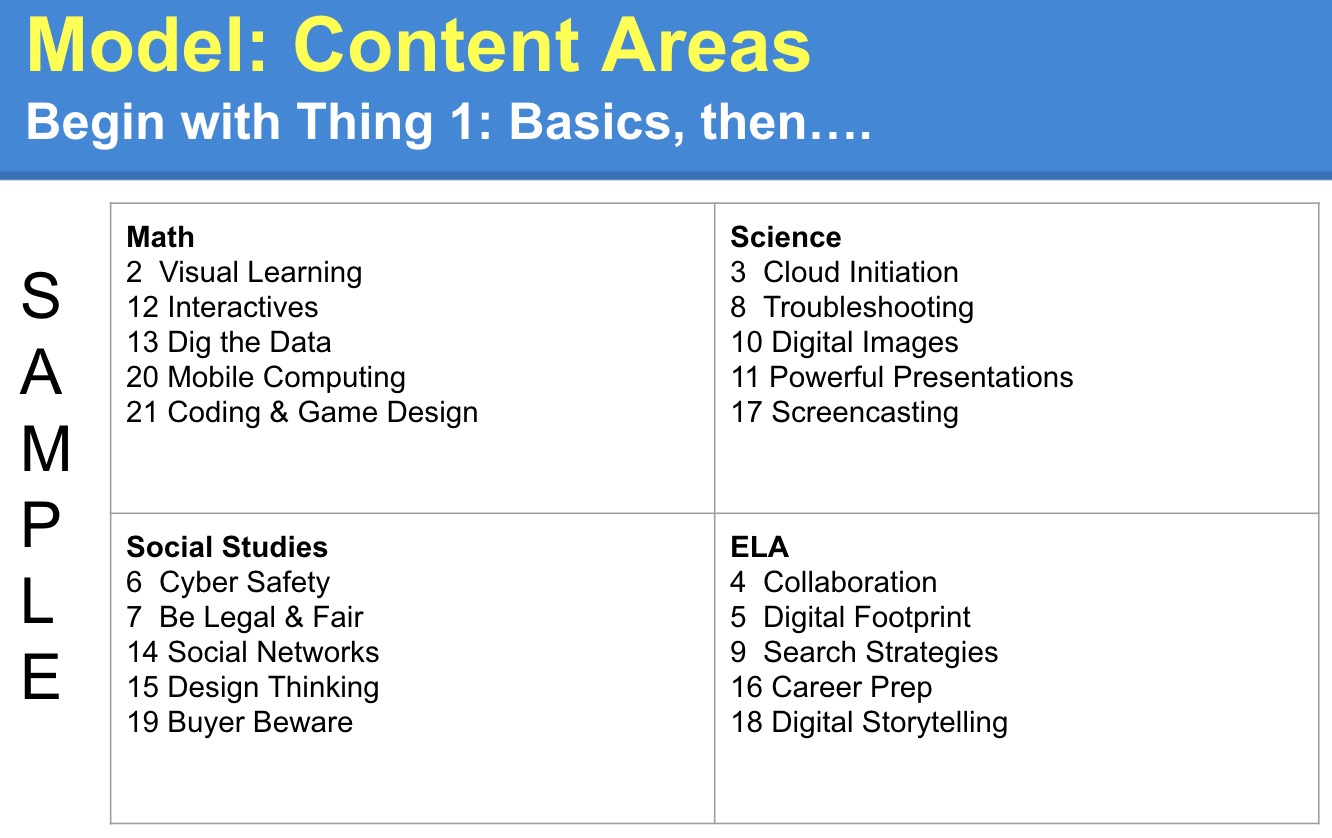Implementation Models
Introduction
The 21 Things 4 Students has been designed to meet the requests by teachers, for flexible delivery. Check with your curriculum and technology coordinators to discuss the most effective delivery method for your school/district.
For flexibility, the Things do not build on each other and can be used in any order, although we do suggest that everyone start with Thing #1 Basics.
In this section, we will cover some of the different models that teachers and districts have been using.
STEPS
1. View this slide show and the separate content blocks to get some ideas for implementation.
Content Areas Model
The Content Area Model refers to the core content areas: ELA, Math, Science and Social Studies.
Thing 1 Basics would need to be covered by one teacher, media specialist, or technology class teacher initially.
The grade level teachers would meet to coordinate which of the 21 Things compliment their setting and curriculum best.

This model was implemented across a district in Shiawassee County, MI. The district staff was involved in curriculum mapping and split the 21things across their different middle school content area courses including the Fine Arts.
Partial year (semester-weeks) model
Some schools have a dedicated computer class period that might run for 6-, 9-, 12-week, or a full semester. In our experience, a dedicated full-year technology class can take an entire school year to complete all 21things.
This model would start with “Thing 1 - Basics”….. and then consider:
- doing some/not all Quests
- your local district goals/priorities
- assessing student skills or abilities for online testing to determine needs
Multiple Years and Grades
This model would start with “Thing 1 - Basics”….. and then select which things would be covered in each grade.
Example:
- Grade 5: Things 1-7
- Grade 6: Things 8-14
- Grade 7: Things 15-21
Teachers would use the 21t4s Roadmap to check and coordinate student progress.
Full Year Model
1. Always plan on starting with the Basics.
2. The teacher guides give an estimated time for the Things and Quests. As the learning process is different for each student and class, you will be the best judge, spending more time on some sections, or skipping some Quests or Things you don't feel are a priority. This is the reason for making it non-sequential and flexible.
3. Use the completion time suggested in the teacher guides to determine the pace.
Project-based Units
One school district teaches 20 week courses divided into three project-based units. They selected the Things that give students the 21st century skills they need to complete the multimedia projects.
Unit Structure
- Introduce the Big Idea Project
- Teach lessons and do activities that apply
- Apply the learning to the Big Idea Project - GUIDE students to effectively apply their new knowledge.
- Assess through mini quizzes, small activities or checkpoints on big project.
- Students present Big Idea Project/a few each day in the last week/lessons are still taught daily for a portion of the period.
- Reflect on projects and skills learned.
Examples
Basic Orientation/Introduction (5 weeks)
- #1 Basics
- #8 Troubleshooting
Unit 1 Informational/How-to
The focus of this unit is to introduce the students to copyright laws, search strategies, screencasting and video creation.
- #2 Visual Learning
- #7 Be Legal and Fair
- #8 Search Strategies
- #17 Creative Communications
Unit 2 Public Service Announcement (5 Weeks)
After the students are introduced to basic technology skills, including troubleshooting, social networking, cyber safety, and digital footprints, they will apply their knowledge to use in the development of the public service announcement (PSA) as the unit project.
- #18 Digital Storytelling
- #14 Social Networking
- #5 Digital Footprint
Unit 3 Persuasive Project (5 Weeks)
Students will understand and apply the skills learned in the previous units; cyber citizenship, electronic file storage/usage, research and citation, images/media manipulation and presentation tools to create a persuasive project using a multimedia presentation format.
Reflections
Make some notes for yourself about which model makes the most sense for your setting, and what your next steps will be if you plan to implement some of these resources.
Standards for Educators
Addressing the ISTE Standards For Educators
Learner
1a. Set professional learning goals to explore and apply pedagogical approaches made possible by technology and reflect on their effectiveness.
1c. Stay current with research that supports improved student learning outcomes, including findings from the learning sciences.
Leader
2b. Advocate for equitable access to educational technology, digital content and learning opportunities to meet the diverse needs of all students.
2c. Model for colleagues the identification, exploration,
evaluation, curation and adoption of
new digital resources and tools for learning.
Collaborator
4b. Collaborate and co-learn with students to discover and use new digital resources and diagnose and troubleshoot technology issues.
Designer
5a. Use technology to create, adapt and personalize learning experiences that foster independent learning and accommodate learner differences and needs.
5b. Design authentic learning activities that align with content area standards and use digital tools and resources to maximize active, deep learning.
5c. Explore and apply instructional design principles to create innovative digital learning environments that engage and support learning.
Facilitator
6a. Foster a culture where students take ownership of their learning goals and outcomes in both independent and group settings.
6b. Manage the use of technology and student learning strategies in digital platforms, virtual environments, hands-on makerspaces or in the field.
6c. Create learning opportunities that challenge students to use a design process and computational thinking to innovate and solve problems.
6d. Model and nurture creativity and creative expression to communicate ideas, knowledge or connections.
Additional Resources
Triple E Framework Instructional Strategy Examples
- for Engagement, Enhancement, Extension for implementing technology in the school
